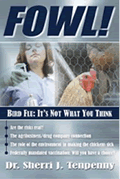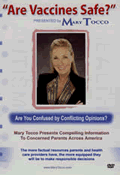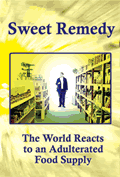Other
Tenpenny
Articles:
The Flu Season Campaign Begins
Vaccinations and The Right to Refuse
CHALLENGING THE VACCINATION DOGMA
Dr.
Sherri Tenpenny, DO
July 15, 2007
NewsWithViews.com
A chilling, consistent pattern exists in stories told by parents:
�My child was happy, healthy and normal. He was walking, learning to talk and interacting with his siblings. He was normal in every way?until his one-year well-baby check up. The ddoctor said it was time for his next round of shots. Unquestioning, the shots were given. Within weeks, he was autistic.�
The reports vary slightly in content and timing, but the descriptions of thousands of children who suddenly regress into the isolated world of autism are eerily the same.
What is dogma?
Webster�s defines dogma as �a doctrine; a positive arrogant assertion of opinion� and medical dogmas certainly abound. Many have existed for decades simply because a claim of effectiveness was made and never disputed. Over time, the allegations were melded into medical jargon, presumed to be facts.
An early example of dogma in the vaccine industry occurred in 1913 when Dr. Simon Flexnor held out that polio was a disease caused by a virus entering the body through the nose and mouth. He postulated that paralysis arose when the virus traveled directly from the sinuses to the brain and the spinal cord. Flexnor�s assertions about the mode of paralysis were never reproduced and it is now known that polio is a gastrointestinal virus, not a respiratory virus.
Difficulties in developing a vaccine occurred because he propagated a dogma that the polio virus would only grow in neurological tissue, a culture media that was associated with life-threatening encephalitis in experimental animals.[1] No one attempted to use other types of tissue cultures to grow polioviruses. His solo paper remained unquestioned dogma for 25 years until Dr. John Enders found, serendipitously, that the virus would indeed grow in a variety of different tissues. When Enders� revolutionary discovery was published in Science, January 28, 1949, the entire virology community immediately accepted the new findings. The polio vaccine was produced within five years. A scientific claim passed off as dogma vanished when challenged by scientific fact.
Present day vaccine dogma is promoted by The Institute of Medicine (IOM), a group of ostensibly impartial physicians, scientists and researchers. After reviewing the industry-funded research papers concluding there is no connection between vaccines and autism, the IOM similarly concludes there is no connection between vaccines and autism. How could they come to any other conclusion?
The phrase, �temporal association does not prove causality� means that even though two events occur at the same time, one event does not cause the other.� The IOM supports the dogma purported by the American Academy of Pediatrics: Since autism occurs chronologically around the same time as the first year vaccinations, angry parents need something to blame.
Parents blame the vaccine, but medical officials blame the defective child, a position supported by the government at the Centers for Disease Control (CDC.) The following statement was published in the CDC�s publication on infection diseases, referred to as The Pink Book:
�There is no distinct syndrome from vaccine administration, and therefore, many temporally associated adverse events probably represent background illness rather than illness caused by the vaccine?.the [vvaccine] may stimulate or precipitate inevitable symptoms of underlying CNS disorder, such as seizures, infantile spasms, epilepsy or SIDS. By chance alone, some of these cases will seem to be temporally related to [the vaccine].�[2]
Current investigations are searching for a genetic cause for autism.[3] The identification of corrupt genes will give ammunition to public health and medical officials who are quick to point an incriminating finger at defective parents.
Safety assumptions
The classic example of unquestioned dogma is the long held notion that the sun rotated around the earth. In 1530, Copernicus challenged the assumption with evidence that the earth rotated on its axis once daily and traveled around the sun once yearly. A fantastic concept for the times, the new information was considered heresy. Later, when Galileo supported Copernicus' conclusions, he was imprisoned, subjected to a trial by Holy Inquisitioners, and forced to withdraw his evidence to save his own life.
Similarly, parents are forced into vaccination decisions by modern day medical inquisitioners. Threats include expulsion from the medical practice and calls to children�s protective services with accusations of medical neglect. Parents are told vaccines are safe and necessary for keeping children healthy. But are they really safe?
Vaccination is a medical treatment, and, like dogmas, assumptions regarding the effectiveness of medical practices abound. A report published by The Government Accounting Office (GAO) in 1978 concluded that �only 10 to 20 percent of all procedures currently used in medical practice have been shown to be efficacious by controlled trials.�[4] In other words, up to 90 percent of accepted medical practices are assumed to be effective without proof. Vaccination falls into this category.
Contrary to repeated claims by the government and the pharmaceutical industry, vaccines have never been proven to be safe by the gold standard of medical research: The double-blind, placebo controlled investigation. In a placebo-controlled study, the safety of a medication is determined by comparing it to a neutral substance, such as a sugar pill. In vaccine safety trials, a new vaccine is not compared to an inert compound such as a shot of sterile water. Instead, the �placebo� is another vaccine. If the number of side effects caused by the experimental vaccine is found to be the same as the number of reactions caused by the placebo-vaccine, manufacturers declare the new vaccine to be �as safe as placebo.�
Another trick used by investigators to promote the safety of vaccines is to discount any part of the study�s data that suggests a problem. The following excerpt from a clinical trial demonstrates how a placebo-vaccine is used and the elimination of negative data occurs. The study was designed to determine the safety of Comvax�, a vaccine combining the Haemophilus influenza vaccine (HiB) and the hepatitis B vaccine into one shot.
�During the study, 17 children (1.9 percent) had an event within 14 days of vaccination that met one of the defining criteria of a serious adverse experience. These experiences included seizure, asthma, diarrhea, apnea (stopped breathing) [and others.] Virtually all of these adverse experiences were classified as serious because they involved a hospitalization. None was judged by the study investigators to be causally related [caused by] Comvax� or the placebo [the two vaccines given separately.] In addition, three deaths among participants in this study were attributed to sudden infant death syndrome [SIDS] occurred greater than14 days after administration of a dose of vaccine (on days 29, 31, and 38, respectively.) Again, none [of the deaths] was judged by the investigators to be related to vaccination.�[5]
The placebo in this study, the HiB and the hepatitis b vaccines, was a vaccine given as two separate shots. Because the number of side effects from the single shot was similar to the number of side effects induced by the separate shots, Comvax� was declared to be �as safe as placebo.� Investigators nullified the association between the vaccines and SIDS with a stroke of the pen. Comvax� was declared to be �well-tolerated.�
Defining effective
Researchers define an effective vaccine as one that creates antibodies after being deposited into the bloodstream, a response called �positive seroconversion.� One vaccine is considered to be more effective than another, from a researcher�s perspective, if the first vaccine induces a larger antibody response than the second.[6]
The medical community and the general public define an effective vaccine as a vaccine that protects a person from the infection they have been vaccinated against. For example, the chickenpox vaccine is considered to be effective by doctors if, in the case of an outbreak, those vaccinated do not contract chickenpox.
The definitions differ substantially and have considerably different ramifications, mostly because the presence of an antibody does not assure the person will be protected from infection. Many outbreaks have occurred in fully vaccinated populations. One example was an out break of measles that occurred in a group where more than 99 percent of the population had been vaccinated.[7] Many outbreaks of chickenpox and mumps have occurred when children were fully vaccinated.[8]
A substantial body of evidence demonstrates that antibodies do not assure that a will be vaccine clinically effective. The package insert of the HiBTiter�, a vaccine to protect against an infection by the H. influenza b bacteria, clearly states �the contribution [antibodies make] to clinical protection is unknown.�[9] Similar findings have been reported about the pertussis vaccine: �The findings of efficacy studies have not demonstrated a direct correlation between antibody response and protection against pertussis disease.�[10] Even tetanus has occurred in patients with high anti-tetanus antibody levels.[11] The esteemed medical journal, Vaccine, states clearly, �It is known that, in many instances, antibody titers do not correlate with protection.�[12]
The dogma that vaccines are safe and effective has become a medical sacred cow, an icon regarded to be above criticism or attack. Challenges to vaccination have often been written off as conspiracy theories. Parents have learned through experience the difficulties of challenging their pediatrician�s vaccine mandates. Nonetheless, many are resisting the medical profession�s dogmas about vaccines and many are refusing vaccinations for their children.
|
Subscribe to the NewsWithViews Daily News Alerts! |
A benchmark in a civilized society is the absence of infectious diseases, a doctrine that emerged during the pre-antibiotic era. Public health officials attribute low infection rates to mandatory vaccination policies rather than giving credit to improved personal hygiene and modern conveniences such as indoor plumbing. It is time for the truth about vaccines to be widely known. Vaccine safety has not been proven. Vaccines provide false security about protection. Vaccines can cause harm. It is time to dispense with the �safe and effective� dogma before one more person is harmed.
Footnotes:
1,
Rogers, Naomi. Dirt and Disease, Polio before FDR. (New Brunswick:
Rutgers University Press, 1996), p. 24
2,
CDC. Epidemiology and Prevention, The Pink Book, 6th Edition, Chapt
6: Pertusus. pg 80
3,
"Genetic cause of
autism." January 18, 2006
4,
Assessing the Efficacy and Safety of Medical Technologies. Washington,
D.C. Congress of the United States, Office of Technology Assessment,
Publication No. 052003-00593-0. 1978. Government Printing Office,
Washington, D.C. 20402
5,
West, David., et. al. "Safety and immunogenicity of bivalent H. influenza
type b/hepatitis B vaccine in healthy infants. Ped. Inf. Dis. J 1997;16:593-599.
6,
CDC. MMWR. Pertussis Vaccination: Use of Acellular Pertussis Vaccines
Among Infants and Young Children. March 28, 1997/Vol. 46/No. RR-7,
p.4
7,
Gustafson, T.,et.al.NEJM 1987;316-771-774.
8,
NMASeminars.com
9,
HibTiter� vaccine package insert. Physician's Desk Reference, 2002.
Vol. 56. pg. 1860.
10,
CDC.
MMWR. Pertussis Vaccination: Use of Acellular Pertussis Vaccines Among
Infants and Young Children. March 28, 1997/Vol. 46/No. RR-7, p.4
11,
Crone, Nathan E and Reder, Anthony T. Reder. Severe tetanus in immunized
patients with high anti-tetanus titers. Neurology.42:761, 1992.
12,
Del Giudice G, Podda A, Rappuoli R. What are the limits of adjuvanticity?
Vaccine. 2001 Oct 15;20 Suppl 1:S38-41.
�
2007 Sherri Tenpenny - All Rights Reserved
Dr. Sherri J. Tenpenny is respected as one of the most knowledgeable and outspoken physicians in the country regarding the negative impacts of vaccines on health. Through her education company, NMA Media Press, she spreads her vision of retaining freedom of choice in healthcare, including the freedom to refuse vaccination. Her three hour DVD, Vaccines: The Risk, The Benefits and The Choices, her new book FOWL! Bird flu: It�s Not What You Think, and many other books, tapes and materials are available HERE. Information about her medical clinic in Cleveland, Ohio can be found HERE.
Dr. Tenpenny is a regular columnist for www.NewsWithViews.com. Her new book FOWL! are available through this site; other tapes and materials are available www.DrTenpenny.com
Website: www.DrTenpenny.com
E-Mail: nmaseminars@aol.com
The classic example of unquestioned dogma is the long held notion that the sun rotated around the earth. In 1530, Copernicus challenged the assumption with evidence that the earth rotated on its axis once daily and traveled around the sun once yearly. A fantastic concept for the times, the new information was considered heresy.















